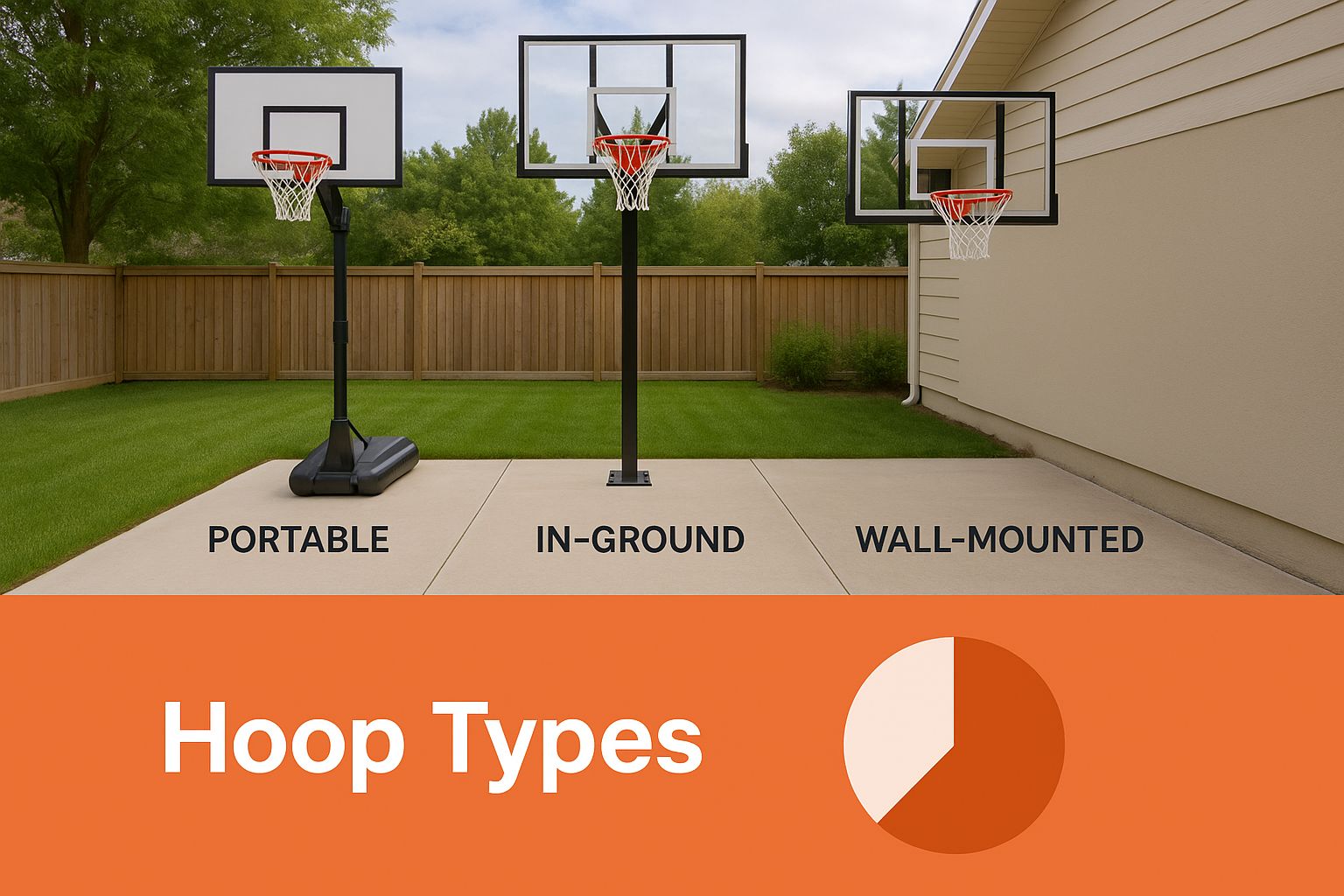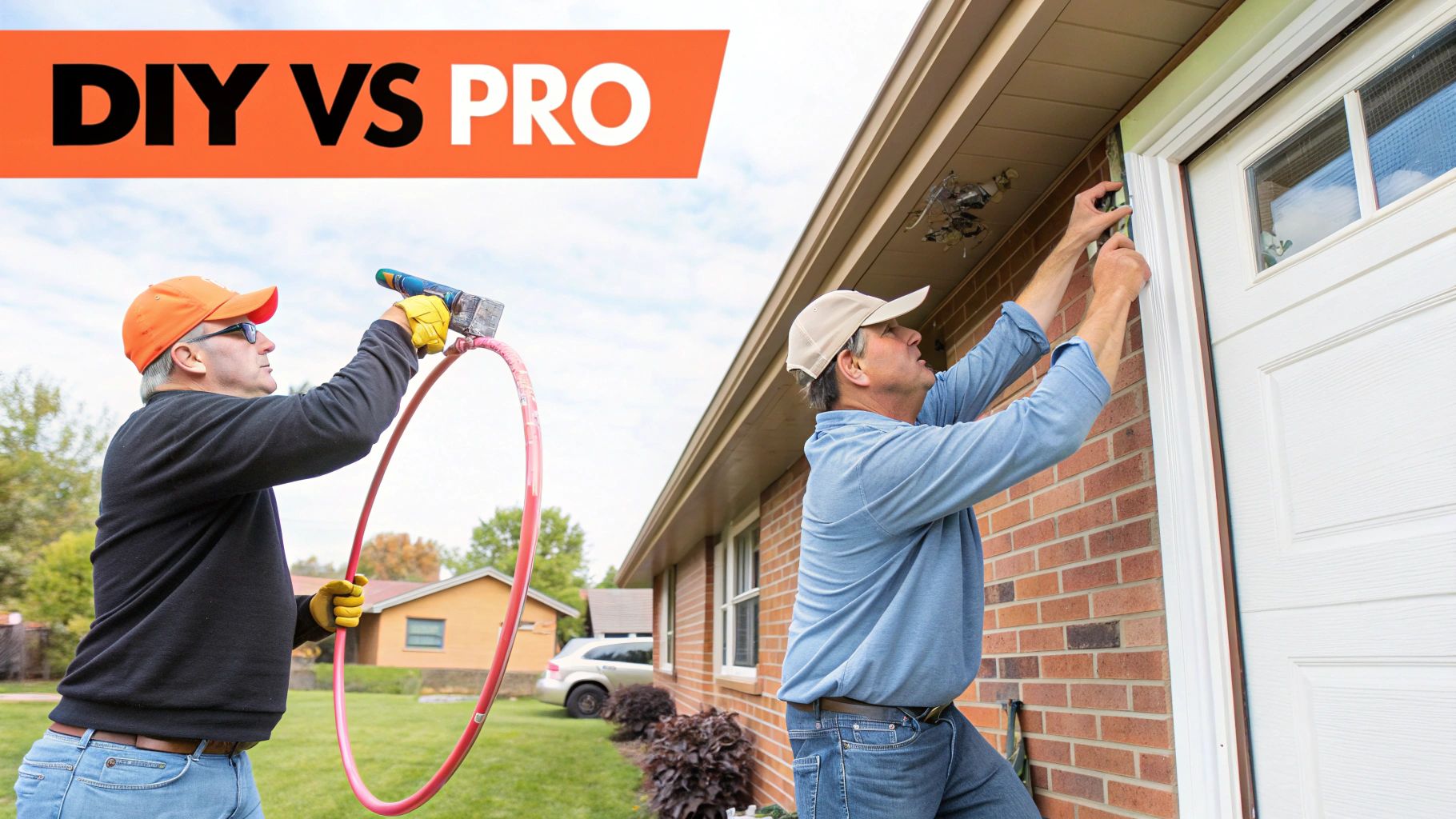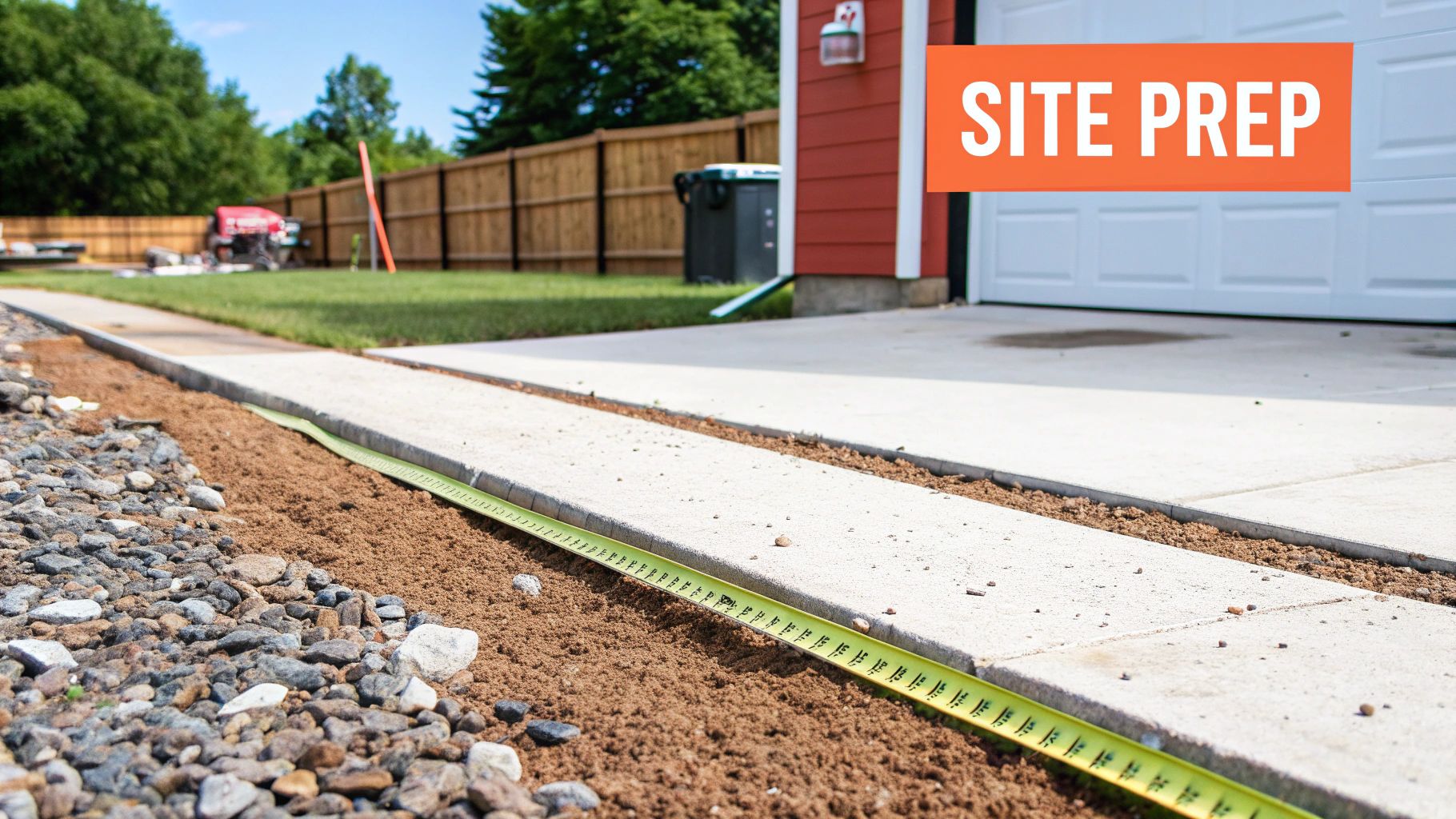-
CALL US:
- (866) 952-3456
Buying a basketball hoop isn't just about grabbing some sports equipment; it's more like planting a tree – you're making a long-term investment in family fun and fitness. You put in the initial effort and money, and over time, you reap the rewards. But why do some hoops cost a few hundred bucks while others cost thousands? Let's break down the different things that influence the final price, so you can budget effectively.
Believe it or not, the basketball hoop market is huge and growing. It was valued at about $2.82 billion in 2024 and is expected to reach $4.52 billion by 2033! This shows how popular the sport is becoming. You can find out more about the basketball hoop market here: basketball market research. This growth means there are more options than ever, but it also makes figuring out the costs a bit more complicated.
So, what actually makes up the cost of installing a basketball hoop? Several things contribute. The type of hoop is a big one. Portable hoops are usually the cheapest, while in-ground hoops require a bigger initial investment. But remember, the upfront cost isn't the only thing to think about. You also need to factor in things like long-term maintenance, potential repairs, and even how it might affect your property value down the line.
The installation process itself also adds to the cost. Doing it yourself (DIY) can save you money, but it takes time, tools, and a bit of know-how. Think of it like building furniture from IKEA. It can be done, but it takes time and patience. Professional installation, on the other hand, ensures it's set up correctly and safely, but it comes with labor costs. Understanding all these factors will help you make the right decision for your budget and what you're looking for in the long run.
Choosing a basketball hoop feels like picking the right tool for the job. A simple task needs a simple tool, but a long-term project requires a more serious investment. Similarly, different basketball hoops come with different price tags and installation costs. Let's break down what you can expect to spend, comparing portable, in-ground, and wall-mounted options.

This infographic illustrates the three main types: portable, in-ground, and wall-mounted. Just by looking, you can see the difference in scale. An in-ground hoop is a much more substantial installation than the other two.
Portable hoops are attractive because of their initial price, typically between $150 and $500. It's like grabbing a quick snack – satisfying in the moment, but not necessarily a full meal. However, remember that portable hoops often have a shorter lifespan, can be easily damaged, and require regular base refills. These ongoing costs can add up over time.
In-ground hoops are the heavy hitters, with initial costs ranging from $400 to over $2,000. Think of them as building a solid foundation – it's a more significant upfront investment, but provides stability and durability for years to come. Their robust construction means fewer repairs and replacements down the line. Labor for installation can add to the cost, falling somewhere between $1,626 and $2,581 as of April 2025, according to Homewyse. This added expense is like hiring a contractor for a home improvement project – it’s a specialized job that requires expertise.
Wall-mounted hoops offer a middle ground, priced between $150 and $750. They're like finding the sweet spot between portability and permanence. More stable than portable hoops, they require less investment than in-ground systems. Remember to consider your wall type and the necessary bracket system, as these will impact the final installation cost.
To help you visualize the cost differences, let's look at a comparison table:
Basketball Hoop Installation Cost Comparison
This table compares costs across different hoop types including equipment, labor, and total investment.
| Hoop Type | Equipment Cost | Installation Cost | Total Investment | Installation Time |
|---|---|---|---|---|
| Portable | $150 – $500 | Minimal (DIY) | $150 – $500 | A few hours |
| In-Ground | $400 – $2,000+ | $1,626 – $2,581+ | $2,026 – $4,581+ | 1-2 days |
| Wall-Mounted | $150 – $750 | Varies depending on wall and bracket | $150 – $750+ | A few hours – 1 day |
As you can see, while portable hoops have the lowest initial cost, in-ground hoops offer the greatest long-term value due to their durability. Wall-mounted hoops provide a balance between cost and stability, making them a suitable option for those who want something more permanent than a portable hoop without the significant investment of an in-ground system. Choosing the right type depends on your budget, needs, and how long you plan to use the hoop.
Ever faced the dilemma of baking a cake from scratch versus grabbing one from the bakery? Both get you a tasty treat, but one demands more time, effort, and, let’s be honest, a higher chance of things going sideways. Choosing between DIY and professional basketball hoop installation is a similar predicament. You might think you're saving money by going the DIY route, but a botched installation can lead to a real headache (and a hefty bill) down the line. Let's explore the nitty-gritty of both options to help you choose the right path.
Setting up a portable basketball hoop is generally pretty simple. Think of it like assembling a piece of furniture – follow the instructions, and you're good to go. In-ground hoops, however, are a whole different ball game. We're talking concrete, precise measurements, and the potential for buried utility lines – a job best left to the pros. Professional installers have the experience and specialized tools to guarantee a safe and stable setup, minimizing the risk of costly mistakes. It's like calling a plumber for a complicated plumbing issue; you're paying for their expertise to prevent a bigger disaster.
While DIY might seem like the budget-friendly option, common mistakes can quickly turn that upside down. Incorrectly mixed concrete, a hole that's too shallow, or inadequate backboard support can lead to an unstable hoop, requiring expensive repairs or even a complete do-over. Imagine baking a cake and forgetting the baking powder. It might look okay at first, but the end result is going to be… disappointing. Similarly, a poorly installed basketball hoop can be a recipe for frustration and unexpected expenses. For a helpful guide on assembling a basketball hoop, check out this resource.
Professional installers bring more than just brute strength to the job; they bring a wealth of knowledge and experience. They're familiar with local building codes, proper installation techniques, and how to handle unexpected issues that might pop up during the process. This expertise significantly reduces the chance of costly errors and ensures a safe, long-lasting installation. Plus, professional installation often comes with a warranty, giving you peace of mind and protection against future problems. It's like buying a cake from a trusted bakery – you're paying for quality and a guarantee. Understanding the potential pitfalls of DIY and the advantages of hiring a pro will empower you to make the best decision for your budget and your long-term satisfaction.

Imagine planning your dream backyard basketball court, complete with a shiny new hoop. You've budgeted carefully, factoring in the cost of the hoop itself. But then, BAM! The final bill arrives, and it's significantly higher than you anticipated. Sound familiar? Unfortunately, this scenario plays out often with home improvement projects. Hidden costs related to basketball hoop installation can sneak up and throw off even the most meticulous budget. Let's explore these often-overlooked expenses so you can avoid any financial surprises.
One common hidden cost is utility line marking. Before you even think about digging a hole for an in-ground hoop, you absolutely must know what's lurking beneath the surface. Think buried gas lines, electrical cables, and other vital utilities. Damage to these could be disastrous and incredibly expensive to repair. Locating these lines is often a mandatory step and typically costs between $50 and $200. It's a small price to pay for peace of mind and avoiding a potential catastrophe.
Another factor that can significantly impact the final cost is site preparation. Let's say your yard isn't perfectly level. You might need some landscaping work to create a flat, stable surface for the hoop. Think of it like prepping a garden bed – sometimes you need more than just a trowel and some potting soil. Removing rocks, roots, or other obstacles can add hundreds, or even thousands, to the project's overall cost. For a deeper dive into how hidden factors can affect other projects, you might find our furniture assembly cost guide insightful.
Even seemingly minor details can influence the final price tag. For example, concrete needs time to cure, especially in colder weather. This can delay your project, which might mean rescheduling installers and incurring extra labor costs. Similarly, imagine needing more concrete than initially calculated, or discovering you need specialized brackets. These unforeseen material needs can quickly add up.
Then there are those “optional” extras that are, let’s be honest, pretty essential. Backboard padding, for example, is crucial for player safety and can extend the life of the backboard. For in-ground hoops, a ground sleeve allows for easy removal and relocation. This is a huge advantage if you move or decide to redesign your landscaping. While these "extras" add to the upfront cost, they offer significant long-term benefits and are well worth the investment.
Understanding these potential hidden costs will help you create a more accurate budget and avoid unwelcome surprises during your basketball hoop installation. It’s all about planning ahead and being prepared.
Think of site preparation like laying the foundation for a house. It's not the glamorous part, but it's absolutely essential for a solid, long-lasting structure. Similarly, prepping your basketball hoop site isn't the fun part, but it’s crucial for a stable and durable installation. Many people underestimate this stage, but trust me, it's worth paying attention to.

Just like building a house, various factors can impact your site preparation costs. One of the biggest is the soil condition. Think about it: digging a hole in soft soil is much easier than wrestling with rocks. Rocky terrain often requires specialized equipment like jackhammers, which can significantly increase the cost to install a basketball hoop.
Another factor is the presence of underground utilities. Before you even think about digging, you absolutely need to have these marked. This is a non-negotiable safety precaution and adds to the overall project expenses. Similar to unexpected plumbing issues in a house renovation, hitting a utility line can cause major headaches and blow your budget. Thinking about all potential Home related costs is crucial.
Imagine trying to get a grand piano up a narrow staircase. Tricky, right? The same principle applies to your basketball hoop installation. Difficult-to-access locations can increase labor costs. If heavy machinery can't reach the site, workers might have to haul materials by hand, adding time and expense to the project.
Even something as unpredictable as the weather can influence the cost. Rain delays can push back the project timeline, and unexpected ground conditions can add unforeseen expenses.
The key takeaway here is to plan meticulously. Before you start, carefully assess your site. Check for those underground utilities, evaluate your soil, and consider how accessible the location is. Being aware of these factors upfront will help you accurately estimate the cost to install a basketball hoop and avoid unpleasant surprises. Just like a detailed blueprint for a house, proper planning for your basketball hoop project will save you money and ensure a smooth installation process. You might also be interested in planning for a home gym assembly as well.
Sometimes, that simple backyard hoop just isn't enough. It's like craving a quick snack and ending up ordering a five-course meal. You started with free throws, but now you’re picturing a full-blown basketball court. But when does this upgrade make sense, and when is it just a budget-busting fantasy?
The cost of installing a basic basketball hoop is just the tip of the iceberg. A standalone hoop is one thing, but a full court is a whole different ball game, financially speaking. Building a full backyard court involves a significantly higher investment. As of 2025, the average cost hovers around $35,000, but prices can range from $8,600 to $42,000. This depends on factors like court size, the materials you choose, land grading, drainage, and whether you want lighting. You can learn more about basketball court costs here. This considerable price jump requires some serious thought.
So, is a full court really worth the expense? The answer really depends on your individual circumstances. Think about how often your family will actually use it. Do you have the space, and is the terrain suitable? And what about the ongoing maintenance? Just like a car, a basketball court needs upkeep. Beyond the hoop itself, maintaining the surrounding area can also impact your long-term costs. For a glimpse into ongoing property expenses, consider the costs associated with HOA common area maintenance. Asking these questions is essential before you make any decisions.
Building a full court involves a lot more than just the court surface itself. Think of it like building a house; there's the foundation, the walls, the roof, and all the finishing touches. Site preparation, including grading the land and ensuring proper drainage, can be a major expense. Then there’s the court material itself, which can range from basic asphalt to specialized sport court surfaces. Adding features like lighting, fencing, and seating will bump up the price even further. And don't forget about ongoing maintenance, like resurfacing and repairs, which needs to be part of your long-term budget. Understanding these costs is key to making a smart investment.
Let's break down the costs with a helpful table:
Basketball Court Construction Cost Breakdown
Detailed cost analysis for full court construction including surface materials, site preparation, and additional features
| Component | Cost Range | Percentage of Total | Key Factors |
|---|---|---|---|
| Site Preparation | $5,000 – $15,000 | 15% – 45% | Land grading, excavation, drainage installation |
| Court Surface | $10,000 – $25,000 | 30% – 70% | Material type (asphalt, concrete, sport court) |
| Lighting | $2,000 – $5,000 | 5% – 15% | Number of lights, type of fixtures |
| Fencing | $1,000 – $3,000 | 3% – 9% | Material (wood, metal, vinyl), height |
| Additional Features (e.g., seating, backboards) | $1,000 – $5,000 | 3% – 15% | Type and quality of features |
The table above gives a general overview. Remember, these percentages and cost ranges can vary significantly depending on your specific project requirements.
For many families, a phased approach to construction is more practical. Think of it like building with LEGOs – you start with a base and add pieces over time. Maybe you begin with a basic court and add features like lighting and fencing later on. This spreads the cost over time and lets you adjust the project based on your family’s changing needs. By carefully considering how often you’ll use the court, your property’s characteristics, and your budget, you can make a wise investment that provides years of fun.
Getting a basketball hoop installed doesn't have to be a financial slam dunk. Just like planning a family road trip, a little smart budgeting upfront can make the whole experience smoother and more enjoyable. Let's explore some proven strategies that savvy homeowners use to manage installation costs without compromising quality or safety.
Imagine booking a flight. Prices go up and down depending on the season, right? Well, the same principle applies to basketball hoop installations. Fall and winter are typically the off-season for contractors. Demand is lower, which often translates to lower rates. On the flip side, spring and summer are peak seasons, and you'll likely see higher prices due to increased demand. If you're flexible, scheduling your installation during the off-season could lead to significant savings.
Think about it like packing for that road trip. You can pack snacks and drinks to avoid pricey gas station stops, but you wouldn't skimp on things like gas or tires. Similarly, with a simple portable hoop, a DIY installation might be perfectly reasonable. But for more complex in-ground systems, professional installation is usually the wiser investment. Attempting a DIY project beyond your skill level could lead to costly mistakes, potentially ending up more expensive than hiring a pro in the first place. For some related DIY tips, you might find this helpful: Check out our guide on furniture assembly.
Now, if you're dreaming of a full-court setup in your backyard – that's more like a major home renovation. Financing might be a worthwhile option. These larger projects can actually increase your property value, potentially making you eligible for home improvement loans. It's similar to investing in a kitchen remodel – a significant upfront cost, but one that adds long-term value to your home.
Don't be shy about negotiating with contractors. It's like haggling at a flea market – perfectly acceptable to ask for a better price. Get multiple quotes from different contractors and compare them carefully. Also, stay actively involved throughout the installation process. Closely managing the project can help prevent unexpected costs and ensure everything stays on track. By making informed decisions and planning carefully, you can create the perfect basketball setup that your family will enjoy for years to come.
Ready to turn your basketball dreams into reality? Contact Assembly Smart for professional and reliable installation services. We handle everything from basic hoops to full-court setups, ensuring a smooth and stress-free experience.